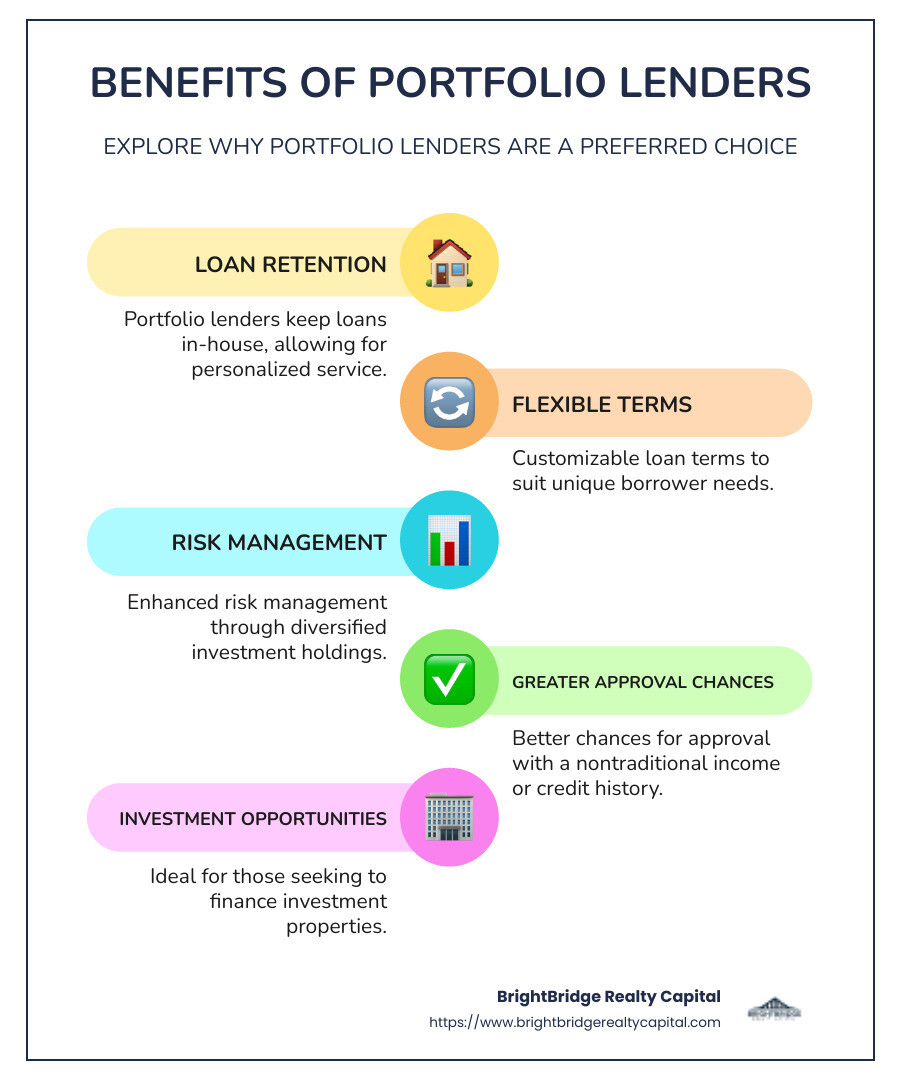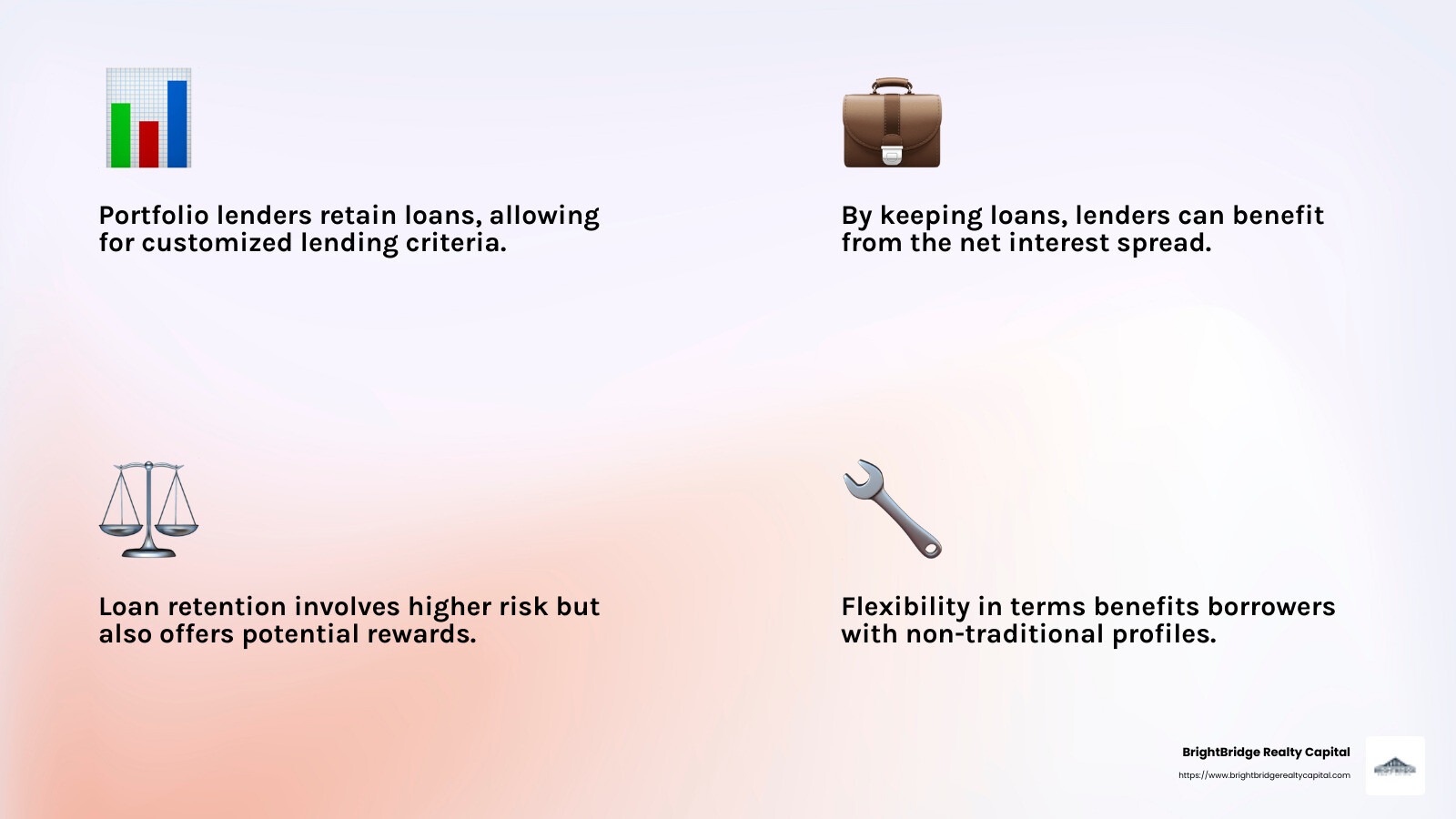The Ultimate Guide to Understanding Portfolio Lenders

Portfolio lenders offer a unique approach to mortgage lending by keeping loans in-house rather than selling them on the secondary market. This method allows them more flexibility in lending standards, making them a great fit for borrowers with non-traditional income or unique financial situations.
- Portfolio lenders retain loans they originate rather than selling them, enabling more personalized loan options.
- Flexible qualification requirements often appeal to borrowers who might not meet conventional loan standards.
- Investment property and jumbo loan seekers typically find more favorable conditions with portfolio lenders.
- Potential for higher interest rates, but comes with greater flexibility and borrower-friendly terms.
In this guide, we'll explore what makes portfolio lenders distinct and why real estate investors often favor them.

Learn more about portfolio lenders:
What Are Portfolio Lenders?
Portfolio lenders are financial institutions that originate mortgage loans and retain them as part of their own investment holdings. Unlike traditional lenders, who sell their loans on the secondary market to entities like Fannie Mae or Freddie Mac, portfolio lenders hold onto their loans. This approach allows them the flexibility to set their own lending standards.
Mortgage Origination
When a portfolio lender originates a mortgage, it means they are creating a loan that they will keep in their portfolio. This is different from conventional lenders who often sell their loans to free up capital. By holding onto the loans, portfolio lenders can tailor their lending criteria to meet the needs of different borrowers.

Investment Holdings
Keeping loans in-house allows portfolio lenders to benefit from the interest generated over time. This strategy can be more profitable because they earn from the net interest rate spread—the difference between what they earn on loans and what they pay on deposits. However, it also means they take on more risk since they are responsible for any defaults.
Key Points:
Personalized Loan Terms: Portfolio lenders can offer more personalized loan terms, making them an attractive option for borrowers with unique financial situations.
Risk and Reward: By keeping loans as part of their investment holdings, portfolio lenders assume more risk but also have the potential for higher rewards.
Flexibility: They offer flexibility in terms like down payments and credit scores, which can be beneficial for those who do not fit the mold of conventional lending criteria.
Portfolio lenders are especially appealing to real estate investors and those looking for investment properties or jumbo loans. Their ability to offer customized solutions can make them a preferred choice for many borrowers.

In the next section, we'll explore how portfolio lenders operate and manage these unique offerings.
How Portfolio Lenders Operate
Loan Retention
Portfolio lenders keep the loans they originate, which means they don't sell them to the secondary market. This allows them to maintain control over the loans and the terms they set. Unlike traditional lenders, who sell loans to investors, portfolio lenders manage their own risk and reward. By holding onto these loans, they can offer more custom solutions to their borrowers.
Flexible Terms
One of the biggest benefits of working with a portfolio lender is the flexibility in loan terms. Because they don't have to follow strict guidelines set by secondary market buyers, portfolio lenders can customize loans to fit unique borrower needs. Whether it's adjusting the down payment or considering nontraditional income sources, portfolio lenders have the freedom to make exceptions that traditional lenders cannot.
Risk Management
While keeping loans in-house allows for flexibility, it also means taking on more risk. Portfolio lenders manage this risk by carefully assessing each borrower's situation and setting interest rates accordingly. Higher interest rates often help offset the risk of potential defaults. Additionally, portfolio lenders may charge prepayment fees, which can act as a financial cushion. This approach allows them to balance the risk while still offering competitive options to borrowers.
Key Points:
Customized Solutions: Portfolio lenders can adjust loan terms based on individual borrower needs, offering flexibility not found with traditional lenders.
Risk and Reward Balance: By retaining loans, portfolio lenders take on more risk but have the potential for greater rewards through interest earnings.
Interest Rate Strategy: Higher interest rates and prepayment fees help manage the financial risk associated with retained loans.
In the next section, we'll explore the advantages and disadvantages of working with portfolio lenders.
Advantages and Disadvantages of Portfolio Lenders
When considering portfolio lenders, weigh both the advantages and disadvantages they offer. Let's break down some key points:
Advantages
1. Easier Loan Approvals
Portfolio lenders often have more relaxed criteria for loan approvals. This is great news for borrowers with nontraditional income sources or those who may not meet the stringent requirements of conventional loans. With fewer restrictions on credit scores and debt-to-income ratios, more people can qualify for loans that might otherwise be out of reach.
2. Faster Access to Funds
Need money quickly? Portfolio loans can provide faster access to funds because they aren't tied to the secondary market. This means less red tape and a quicker approval process, allowing you to secure financing in a timely manner.
Disadvantages
1. Higher Interest Rates
One downside is that portfolio lenders often charge higher interest rates. This is because they take on more risk by keeping the loans in-house. While this can make the loan more expensive over time, it also allows lenders to offer loans to a wider range of borrowers.
2. Prepayment Fees
Another potential drawback is the presence of prepayment fees. These fees are charged if you pay off your loan early. While they help lenders manage their financial risk, they can also increase the overall cost of the loan for borrowers. It's crucial to negotiate these fees upfront to avoid surprises later on.
In the next section, we will discuss who should consider working with portfolio lenders and why these loans might be the right fit for certain borrowers.
Who Should Consider Portfolio Lenders?
Are you wondering if a portfolio lender is right for you? Let's explore some scenarios where these lenders might be a good fit.
Nontraditional Income
If your income comes from nontraditional sources, like freelancing, gig work, or investments, a portfolio lender might be your best option. Traditional lenders often require W-2s or regular pay stubs, but portfolio lenders are more flexible. They look at your entire financial picture, not just your paycheck. This approach can be a game-changer for those with varied or unpredictable income streams.
Investment Properties
Thinking about buying an investment property? Portfolio lenders can be particularly advantageous. They often have no limits on the number of properties you can finance. Unlike traditional lenders, they don't always require properties to be in perfect condition. This is ideal if you're interested in fixer-uppers or want to expand your rental portfolio. Plus, they offer loans even if your credit isn't perfect.
Credit History
If your credit history has a few blemishes, don't worry. Portfolio lenders tend to be more forgiving. They've been known to work with borrowers who have faced bankruptcy or foreclosure. As long as you can show you've bounced back and can repay the loan, you might still qualify. They focus on your current situation and future potential rather than past mistakes.
In the following section, we'll dive into frequently asked questions about portfolio lenders, such as how they differ from traditional loans and whether they are more expensive.
Frequently Asked Questions about Portfolio Lenders
What is the difference between portfolio loans and traditional loans?
The main difference lies in how the loans are handled after they're issued. Portfolio lenders keep the loans they originate in their own portfolio. This means they don't sell these loans on the secondary market like traditional lenders do. Because they hold onto the loans, they can set their own criteria and offer more flexible terms. This flexibility is helpful for those with nontraditional income or those looking to finance multiple investment properties.
Traditional loans, on the other hand, are typically sold to entities like Fannie Mae or Freddie Mac. These loans have to meet strict guidelines to be eligible for resale. This often means stricter requirements for credit scores and income documentation.
Are portfolio loans more expensive?
Yes, they can be. Interest rates for portfolio loans are often higher than those for traditional loans. This is because portfolio lenders take on more risk by keeping the loans on their books. To offset this risk, they might charge higher rates. Additionally, fees associated with these loans can also be higher. Some portfolio lenders might include prepayment penalties to discourage early payoff, which can add to the overall cost.
However, the higher cost can be worth it for borrowers who need the flexibility that portfolio loans offer. Always compare different loan options and consider speaking with a mortgage broker to find the best fit for your needs.
How can I find a portfolio lender?
Finding a portfolio lender might require a bit more legwork than finding a traditional lender. Start by reaching out to local banks and credit unions. These smaller institutions are more likely to offer portfolio loans because they want to build long-term relationships with their clients.
Another option is to work with a mortgage broker. Brokers have access to a wide range of lenders and can help you find one that fits your specific needs. They can also assist in negotiating terms and rates, potentially saving you money in the long run.
By understanding these key differences and costs, you can make a more informed decision about whether a portfolio loan is the right choice for you.
Conclusion
At BrightBridge Realty Capital, we understand that real estate financing isn't one-size-fits-all. That's why we specialize in providing flexible funding solutions that cater to the unique needs of real estate investors. Whether you're flipping, building, or growing a rental portfolio, our goal is to help you succeed with quick and customized loan options.
Why Choose BrightBridge Realty Capital?
Fast Closings: We know that time is of the essence in real estate deals. Our streamlined process allows for closings often within a week, ensuring you can seize opportunities as they arise.
Direct Lending: By cutting out intermediaries, we offer competitive rates and a seamless experience. You work directly with us, allowing for a personalized touch and efficient service.
Nationwide Reach: With our expertise and resources, we provide reliable lending solutions across the country. No matter where your investment properties are, we're here to support your real estate journey.
Choosing the right financing partner is crucial. With BrightBridge Realty Capital, you get a team committed to your success. We offer the flexibility and speed you need to keep your projects on track and your investment strategy moving forward.
Explore our real estate financing solutions to find the right fit for your investment goals. Let us help you bridge the gap between opportunity and success.


